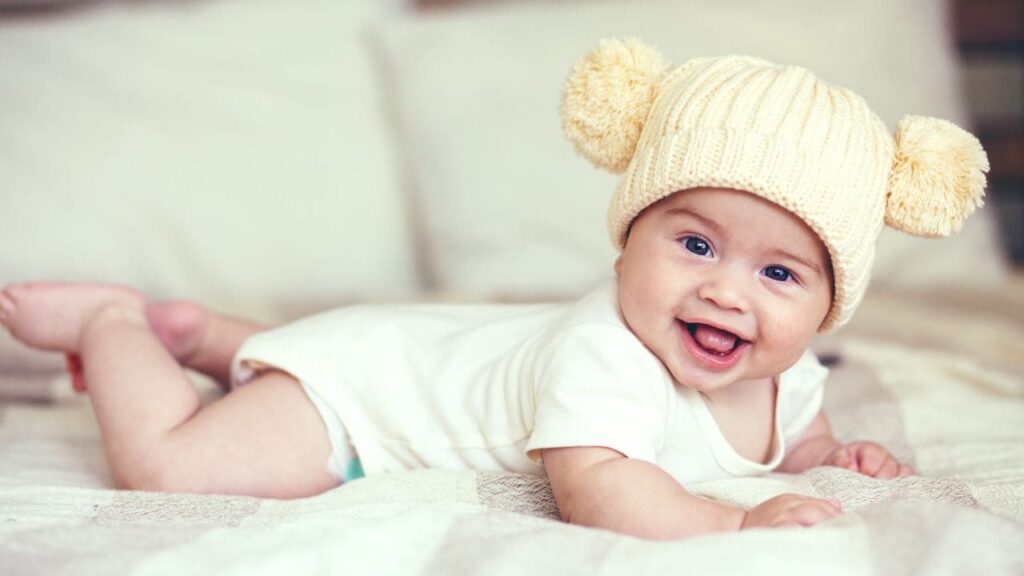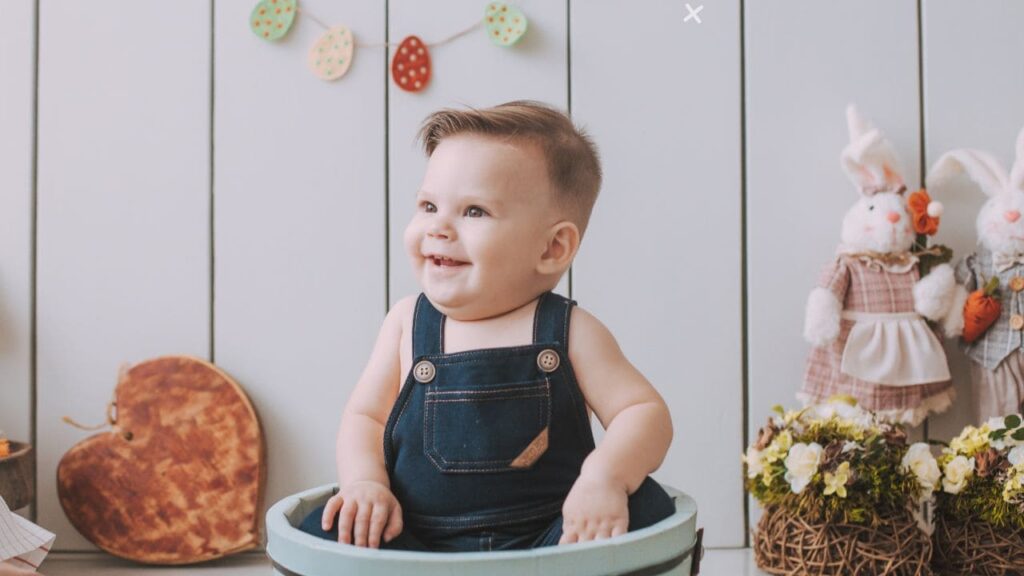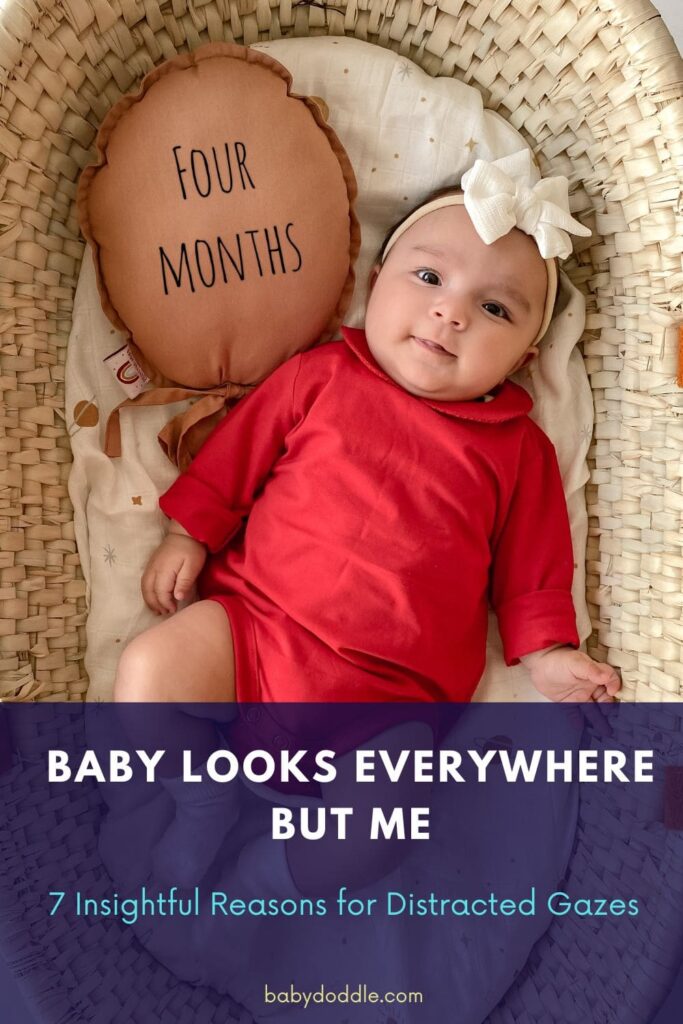As a parent who longs to connect with your little one, few things are more disheartening than having your smiling baby look right past you to gaze at something – or someone – else. You do your best to engage them with silly faces, toys and songs, yet their eyes continue wandering the room instead of locking with yours.
It’s easy to take this personally or worry it means your bond is lacking. But the truth is, several valid reasons for your baby’s fleeting attention span have nothing to do with your relationship. Understanding the common causes behind their distracted staring can prevent unnecessary stress while helping nurture your connection.

Why Won’t My Baby Look At Me?
Before diving into the specifics, it’s important to first realize this phenomenon is incredibly common and developmentally normal. As babies learn how to interpret visual stimuli in their environment, they often appear unfocused or aloof as their eyes dart around to take it all in. Despite their lack of gaze, they are absorbing key information about you and their surroundings during these early months.
Experts actually advise against forcing consistent eye contact too early, as it can overwhelm young infants when what they really need is to explore safely at their own pace. Rest assured, as their vision matures and attention spans lengthen, you can expect those delightful moments of mutual staring to increase.
For now, try seeing their wandering eyes as the wonder-filled process of discovery that it is. Read on for reasons this stage is all part of bonding with your baby, not disconnecting. I’ll also share some tips for capturing their attention when the timing feels right.
It’s Not Personal, It’s Their Developing Vision
Before worrying “my baby won’t look at me,” it helps to understand a bit about how infant eyesight functions during the first months after birth when gazing seems so erratic.* Human vision is incredibly complex, involving everything from basic pupil contraction to neural pathways interpreting the images we see. Babies are rapidly building these capabilities starting from scratch.
While newborns can see objects 8 to 14 inches from their faces, researchers believe images remain out-of-focus for some time. Depth perception, color detection, and tracking movement are also limited but improve dramatically by 6 months old. The peaks and valleys in skill levels contribute to their wandering gaze despite your best efforts to bond.
The good news is that almost all babies have 20/20 vision by preschool age, even if they enter the world needing some visual assistance. So try not to stress about getting them to stare straight at you. In just a few short months, you’ll have sparkling sets of eyes following your every move!
Next, let’s explore some common reasons for distracted baby stares that stem from normal cognitive, physical, and social development. Gaining insight here will help you respond with empathy and compassion.
#1: Exploring New Visual Stimuli
One of the most fundamental human traits present almost from birth is curiosity – that urge to discover the unknown elements of our environments.* For babies embarking on the epic adventure of sight for the first time in their young lives, everything around them offers novel visual stimulation. The need to gather and process all this unfamiliar sensory input outweighs social engagement initially.
Over the first three months, don’t be surprised if your little explorer’s eyes seem to dart around the room constantly. From peeking at colorful mobiles and toys to noting shadows across the ceiling, they are valiantly attempting to decode this barrage of images their brain has never processed before.
While it can feel dismissive when your baby refuses to hold eye contact, remember “This visual roaming is strengthening key parts of their development they’ll rely on to interact with you more meaningfully soon enough.” From motor control, as they track objects to cognitive connections between what they see and hear or touch, it’s all preparation for more advanced communication.
So instead of longing for their eyes to stay trained on you, try encouraging independent gazing that trusted experts call “tummy time.” Limiting time trapped facing outward in carriers, strollers or bouncers allows babies to view their surroundings at their own pace. Soon, their gaze will shift from general environmental stimuli back to your loving face again!
Pro Tip: Initiate contact by moving into their line of vision during tummy time instead of placing them in front of you. Watching you “enter” their world is more likely to pique their interest than staring at your stationary face.
#2: Poor Focusing Abilities
Another factor contributing to your baby’s fleeting gazes is their physical inability to sustain eye contact or fixation. Vision requires precisely coordinated muscle movements to track objects, adjust focal distance, pivot and more. Infants under two months old in particular lack control to hone in on items for more than brief moments.
As mentioned in the last section, the mechanics enabling us to visually concentrate take months to strengthen. Forcing babies to “pay attention” by holding them facing you often backfires, creating fatigue that only exacerbates difficulties locking their stare. Frustration from the inability to comply can even initiate the diving reflex causing them to arch away.
Again, by understanding the normal physical constraints around vision in early months, you can adjust bonding efforts accordingly. Rather than demanding they look at you, focus on slowing down to meet them at their pace and capability level. Once their muscles gain endurance, they’ll become more responsive to visual games like peekaboo that require extended participation.
In the meantime, capitalize on fleeting seconds of eye contact as best you can without pushing them past comfort. Delight at these brief but magical moments of mutual gazing, no matter how sporadic for now.
| Age | Vision Milestones | Tips for Engagement |
|---|---|---|
| 0-2 months | – Focus best 8-14 inches away – See high-contrast patterns -Cannot sustain the gaze | – Use high contrast toys – Sing during feeding – Allow exploring |
| 2-4 months | – Focus better mid-range – Begin tracking moving objects – Recognize some colors | – Use color pictures – Play tracking games – Make silly sounds |
| 5-6 months | – Focus best 8-14 inches away – See high-contrast patterns -Cannot sustain gaze | – Read picture books – Play peekaboo – Make exaggerated faces |
#3: Distracted by Colors and Contrast
Here’s a fun developmental fact about infant vision you might find surprising: unlike adults who prioritize details like faces or reading during visual scanning, babies notice bright colors and high-contrast patterns first. This makes complete sense when you consider things from their perspective.
Not only do these bold, vibrant visual elements stand out against backgrounds far easier for their still-developing acuity, but the patterns are intriguing. Strong black and white geometric designs especially captivate young eyes attempting to find order amidst the otherwise fuzzy chaos of images flooding their brain.
Unfortunately for desperate parents, the low-contrast faces of caregivers fail miserably at competing with these colorful attention-grabbers surrounding your baby. But instead of taking offense when your little one ogles the mobile above your head rather than looking at you, view it as an opportunity to connect.
Follow their gaze to the object of interest and explore it together by describing shapes, patterns and colors you spot as you gently re-center their attention. “You like that red ladybug, don’t you? Look how he’s crawling across all those green leaves!”
Binding through narration even when not holding direct eye contact nurtures language development essential to future conversations. This back-and-forth dynamic builds over months into more tangible reward as babies begin to recognize then anticipate beloved faces.
Be patient – it won’t be long before your features become baby’s favorite view as vision rapidly clarifies!
#4: Following Sounds Out of View
Here’s another interesting vision development challenge babies work hard to overcome: the inability to accurately match sounds to visual stimuli, especially when looking in the wrong direction initially.
Long before infants can verbalize words, they communicate through primitive cries, gurgles and coos. Caregivers naturally respond with similar vocalizations to affirm we are listening and spark a connection. Unfortunately for babies, identifying the source of auditory feedback requires a skill called localization that takes time to nail down when vision is still limited.
The result is babies hearing replies to their noises “look” everywhere except straight at the person speaking! This inadvertent game of hide and seek can continue for weeks until their developing brains map the intersection between what ears hear and eyes see. Eventually, it clicks that turning toward familiar voices links to faces gazing back.
Rather than misreading their scanning as disinterest, have some empathy for their struggle to make visual and auditory connections. Again, avoid overwhelming them with too much prolonged face-to-face time in these early months. Allow them periods to freely glance around when conversing as their awareness builds.
Soon, they will discover and delight at your features lighting up in response to their sounds. Strengthening these neural pathways now paves the way for more dynamic communication ahead!
Pro Tip: Say your baby’s name before responding vocally so they associate your voice with their identity. This repetition builds anticipation for your face faster.

#5: Soothing Brain Through Distraction
As anyone who spends substantial time around infants knows, they have notoriously short attention spans. While part of this stems from immature vision development as discussed already, overstimulation also plays a significant role.
Despite their small size and limited mobility, babies work hard to process incredible amounts of novel sensory data each day. Colors, sounds, textures, smells and even tastes bombard their brains with input needing interpretation to fuel exponential growth. But sorting through all this intense newness becomes taxing quickly, something you’ve likely noticed when cries or yawning ramp up suddenly.
Escaping from surrounding stimulation is tough for babies who can’t consciously walk away for breaks as older children or adults might when overwhelmed. One clever way infants self-regulate is by letting their vision go out of focus to create some internal space. In a sense, they zone out by staring blankly rather than hyper-fixating on any particular object, person, or interaction requiring more energy to track.
So next time your baby greets your enthusiastic greeting with a dull gaze instead of excitement, consider it their version of putting on brain noise-canceling headphones rather than outright rejection. By resisting urges to continually grab their attention, you teach them valuable skills in managing inputs that aid development. Allow them to dictate periods of connection versus set aside solo distraction time.
Pro Tip: Notice signs of potential overstimulation like crying, twitchiness or yawning that signal a need to create calmer environments where they can recover cognitive focus.

#6: Connecting Through Other Communication Cues
Let’s switch gears a bit to highlight another key reason your baby might not sustain much eye contact despite a strong connection with you. We’ve focused a lot so far on why vision issues alter gazing behaviors in the early months. But even babies with excellent sight rely more heavily on other senses, especially touch, to interact initially.
Unlike primal communication cues like crying that serve survival needs from birth, vision requires higher-order thinking to decode. Infants don’t innately realize eyes convey complex messages about thoughts and emotions for many weeks. Yet long before they interpret moods through gazing, babies recognize primary caregivers by smell, sound and feel.
Skin-to-skin contact, hearing mom’s heartbeat in utero then nursing rhythms after birth and distinctive scents bonding baby to breast milk nourishment all forge foundational ties that vision enhances later. So while your baby’s eyes might wander the room, have confidence in your established rapport through other senses not involving visual interaction.
This insight should reassure worried parents who fear short gazing spells equate to emotional distance. In fact, you can solidify your connection through touch when eye contact proves elusive. Try cradling the baby’s head while speaking lovingly face-to-face even if they don’t lock eyes. The pairing of physical and verbal intimacy underscores your relationship in the absence of visual engagement for now.
#7: Laying Foundations for Joint Attention
Our last stop on this journey to understand distracted baby gazes explores how early social communication emerges through stages long before conversational interactions characterize relationships. While vision plays a starring role eventually, predictable milestones pave the way first.
In the first few months, infants focus almost exclusively on caregivers to serve basic survival needs like eating, sleeping and waste removal. They convey displeasure about unmet desires through primitive cries drawing your attention but hardly notice you beyond a comfort object themselves. Yet this one-sided setup still imparts invaluable emotional and physical experiences that set the stage for future bonding.
Between two and six months as vision clarifies, babies take greater interest in your face when talking or making silly expressions. But it may seem they are looking through rather than directly at you since comprehension is limited. Still, these fleeting moments signal blossoming awareness of back-and-forth social dynamics that will soon become more tangible.
By nine months old, babies understand how to purposefully grab your attention and then gauge your response, like pointing to things excitedly. Caregivers reinforce this joint engagement through praise over the desired object, nurturing a cycle of confirmed communication. Although gazes still waver between topics or when distracted, intents and emotions register on both ends by then.
This trajectory reveals how all stages leading up to sustained eye contact build requisite emotional, cognitive, and visual acuity for meaningful social interactions including conversation. So rest easy if your infant’s stare remains slippery for now. Surrounding them with affection while narrating experiences out loud immerses them in relationship foundations sure to manifest in direct gazes and verbal interactions soon enough!
Pro Tip: Notice when babies observe gestures you make like waving hello or opening your mouth wide. Imitate their sounds and motions in return to model the reciprocity of conversation for the future.
When Should I Be Concerned?
Hopefully, by now you feel more at peace with understanding the various reasons your baby might look everywhere but straight at you even while your connection deepens daily. Remember that avoiding eye contact is developmentally appropriate at this young age. In fact, pressuring them often backfires.
However, if you have persistent gut feelings something is “off” or vision milestones are severely delayed, don’t hesitate to reach out to your pediatrician with any concerns. While it’s normal for gazing to improve gradually over months, extremely abnormal patterns past six months warrant discussions about potential issues requiring intervention.
Here are some questions to ask your doctor if worried:
- Does my baby demonstrate appropriate tracking ability by following moving objects horizontally and vertically without difficulty?
- Are they able to locate sounds by turning their head in a direction by four months old?
- Does attempting to maintain eye contact cause distress like crying or arching away?
- Do their eyes appear misaligned, wandering or instability that could indicate a condition requiring treatment?
Again, the overwhelming majority of babies outgrow initial vision challenges relatively quickly without concern. But discussing any nagging worries with experts rather than friends or “Dr. Google” ensures appropriate steps if needed.
| Age | Concerning Signs to Note | Next Steps if Observed |
|---|---|---|
| 0-3 months | – Eyes appear misaligned – Cannot track to midline by 2 months | – Inform pediatrician -Discuss optic nerve and eye muscle exams |
| 3-6 months | – No attempts to grab dangling toys – Failure to locate sounds with eyes | – Vision screening – Check eye alignment |
| 6+ months | – Eyes don’t converge on objects -Poor visual tracking ability | – Formal vision evaluation – Discuss therapy options |
Ways to Strengthen Your Bond
We’ve covered lots of ground exploring what’s behind your baby’s darting eyes and unfocused gazes in these early months after birth. Hopefully, new insight into normal vision development reassures worried caregivers that creating healthy bonds comes in good time, not overnight.
Still, during periods when your infant remains alert and attentive, engaging them playfully benefits your future relationship. Here are some tips for capturing their visual interest when appropriate without going overboard:
- Sing nursery rhymes or silly made-up songs as you dance gently or make funny faces. The multi-sensory chorus of stimulating melody, kinesthetics and expressions excites the senses simultaneously.
- Try easy turn-taking games like peekaboo that give the baby a chance to briefly glance away while building anticipation for animated interactions.
- Identify favorite toys or mobiles with high color contrast patterns that intrinsically attract their attention as launchpads for back-and-forth verbal exchanges.
- Slow down to appreciate fleeting seconds of eye contact rather than criticizing baby for looking past you by smiling warmly to reinforce visual connection as positive.
- Remember other intimate senses like touch, sound and routine also strengthen attachment security beyond visual gazing alone. Narrate loving words during snuggles or moments lost in their dreamy eyes.
While capturing consistent eye contact remains difficult in the early months, have faith your baby adores you already based on primal sensory cues and caretaking responsiveness. Support their emerging visual journey by delighting in budding shared gazes without demanding too much too soon. The gift of their full attention awaits in good time!
Final Thoughts
As we wrap up this lengthy but hopefully reassuring peek into why your baby might not be locking eyes with you just yet despite healthy development otherwise, let’s review some key takeaways:
- Understanding age-appropriate vision challenges makes sustained gazing difficult initially
- Exploration of stimulating surroundings competes with social staring early on
- Accept short attention spans as their way of self-regulating intense sensory inputs
- Confidently rely on attachment through primal senses beyond just vision for now
- Avoid overstimulation and allow the baby to dictate the pacing of interactions
- Monitor for signs of atypical vision issues warranting discussions with the doctor
- Employ playful games judiciously that draw visual engagement
While longing for lasting eye contact is understandable as new parents, try to curb pressures to perform by appreciating incremental progress. Reinforce emerging social awareness through multiple senses until vision and cognition fully align to support more dynamic interactions ahead.
Most importantly, interpret wandering eyes as the wonder-filled journey of discovery they are rather than personal rejection. Your baby surely find you the most beloved sight of all very soon!
FAQ – Baby Looks Everywhere But Me
Why does my newborn seem to have trouble focusing their eyes on me?
It’s completely normal and expected for newborns (0-2 months) to have difficulty visually focusing directly on caregivers’ faces. Their eyesight is still developing, with limited ability to track objects or sustain attention beyond brief moments. Allow them to explore surroundings at their own pace. Maintain bonding through touch, sound and loving care while their vision matures.
My baby will look at everything but me when I try talking or reading to them. Does this mean they don’t recognize me?
Not at all! Babies digest tons of new visual stimulation daily from colors to shadows to high contrast patterns. Getting distracted by their exciting surroundings isn’t a sign of disconnect from you. Keep narrating experiences to immerse them in language foundations for future conversational interactions. Trust that they adore you already from past sensory memories including your voice and scent.
Are there techniques I can use to help lengthen the few seconds of eye contact I get before my baby looks away again?
Absolutely! When your baby sustains eye contact, provide warm positive feedback through smiles and gentle touches to reinforce it as a pleasant experience instead of forcing longer gazes unnaturally. You can also try slowly moving engaging toys from your face level just past their field of vision to encourage visual tracking skills developing. Just remember not to overwhelm them with overstimulation. Let them dictate comfortable interaction pacing.
What signs should I watch for that might indicate my 3 month old needs an eye exam for vision or developmental delays?
Consult your pediatrician if you observe signs like persistent eye turning, inability to track dangling toys held to midline, failure to locate sounds after multiple months or just an ongoing gut feeling something isn’t right. While delayed milestones resolving by 6 months old are often normal, discussing worries calms fears about missing critical intervention periods if needed.
When can I reasonably expect my baby to start maintaining consistent, lasting eye contact with me?
While the timeline varies slightly for each baby, you can typically expect substantial improvements in visual focusing abilities and social awareness to translate into longer, meaningful eye contact episodes by 6 months old. This coincides with developing depth perception, color vision, recognition memory and understanding of facial expression cues – all helping infants bond more actively through gazes. Stay the course with affection to nurture this eye contact emergence!












